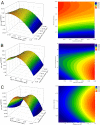The effect of microdosimetric 12C6+ heavy ion irradiation and Mg2+ on canthaxanthin production in a novel strain of Dietzia natronolimnaea
- PMID: 24074304
- PMCID: PMC3849488
- DOI: 10.1186/1471-2180-13-213
The effect of microdosimetric 12C6+ heavy ion irradiation and Mg2+ on canthaxanthin production in a novel strain of Dietzia natronolimnaea
Abstract
Background: Dietzia natronolimnaea is one of the most important bacterial bioresources for high efficiency canthaxanthin production. It produces the robust and stable pigment canthaxanthin, which is of special interest for the development of integrated biorefineries. Mutagenesis employing 12C6+ irradiation is a novel technique commonly used to improve microorganism productivity. This study presents a promising route to obtaining the highest feasible levels of biomass dry weight (BDW), and total canthaxanthin by using a microdosimetric model of 12C6+ irradiation mutation in combination with the optimization of nutrient medium components.
Results: This work characterized the rate of both lethal and non-lethal dose mutations for 12C6+ irradiation and the microdosimetric kinetic model using the model organism, D. natronolimnaea svgcc1.2736. Irradiation with 12C6+ ions resulted in enhanced production of canthaxanthin, and is therefore an effective method for strain improvement of D. natronolimnaea svgcc1.2736. Based on these results an optimal dose of 0.5-4.5 Gy, Linear energy transfer (LET) of 80 keV μm-1and energy of 60 MeV u-1 for 12C6+ irradiation are ideal for optimum and specific production of canthaxanthin in the bacterium. Second-order empirical calculations displaying high R-squared (0.996) values between the responses and independent variables were derived from validation experiments using response surface methodology. The highest canthaxanthin yield (8.14 mg) was obtained with an optimized growth medium containing 21.5 g L-1 D-glucose, 23.5 g L-1 mannose and 25 ppm Mg2+ in 1 L with an irradiation dose of 4.5 Gy.
Conclusions: The microdosimetric 12C6+ irradiation model was an effective mutagenic technique for the strain improvement of D. natronolimnaea svgcc1.2736 specifically for enhanced canthaxanthin production. At the very least, random mutagenesis methods using 12C6+ions can be used as a first step in a combined approach with long-term continuous fermentation processes. Central composite design-response surface methodologies (CCD-RSM) were carried out to optimize the conditions for canthaxanthin yield. It was discovered D-glucose, Mg2+ and mannose have significant influence on canthaxanthin biosynthesis and growth of the mutant strain.
Figures




References
-
- Pangestuti R, Kim S. Biological activities and health benefit effects of natural pigments derived from marine algae. J Funct Foods. 2011;3(4):255–266. doi: 10.1016/j.jff.2011.07.001. - DOI
-
- Brennan L, Owende P. Biofuels from microalgae-a review of technologies for production, processing, and extractions of biofuels and co-products. Renew Sustain Energy Rev. 2009;14(2):557–577.
-
- Khodaiyan F, Razavi SH, Mousavi SM. Optimization of canthaxanthin production by Dietzia natronolimnaea HS-1 from cheese whey using statistical experimental methods. Biochem Eng J. 2008;40(3):415–422. doi: 10.1016/j.bej.2008.01.016. - DOI
Publication types
MeSH terms
Substances
LinkOut - more resources
Full Text Sources
Other Literature Sources

